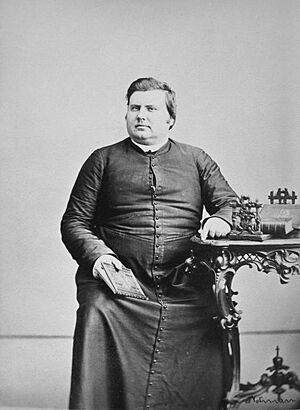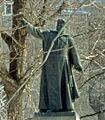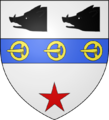Antoine Labelle facts for kids
Quick facts for kids
Antoine Labelle
|
|
|---|---|
 |
|
| Born | November 24, 1833 Sainte-Rose (Laval), Lower Canada
|
| Died | January 4, 1891 (aged 57) Quebec City, Quebec
|
| Occupation | Roman Catholic priest |
François-Xavier-Antoine Labelle (born November 24, 1833 – died January 4, 1891) was a Roman Catholic priest. He is famous for helping many people settle in the Laurentians region of Quebec. People often called him "Curé Labelle" (which means Father Labelle). Some even called him the "King of the North"!
The Story of Curé Labelle
Antoine Labelle was born in Sainte-Rose-de-Lima. His parents, Angélique Maher and Antoine Labelle, were not wealthy. He studied at the Sainte-Thérèse seminary. He loved to read books by famous writers like Auguste Nicolas. He later added François-Xavier to his name to honor Saint Francis Xavier.
Antoine Labelle became a priest on June 1, 1856. He was a very tall and strong man. He stood about 180 cm (5 feet 11 inches) tall. He weighed around 152 kg (335 pounds).
His first job as a priest was in Sault-au-Récollet. Later, he worked in parishes near the United States border. In 1867, he moved to the parish of Saint-Jérôme. This was a more active area.
Building the North
Curé Labelle had a big dream for the Laurentians. He wanted to build a railway line along the Rivière du Nord. This railway would help the area grow and create new jobs.
One of his main goals was to stop French Canadians from moving away. Many people were leaving Quebec to find work in textile factories in New England, USA. Curé Labelle wanted them to stay and build a life in Quebec. He helped about five thousand people settle in the Laurentians!
Important people like Hugh Allan and John Joseph Caldwell Abbott supported Curé Labelle. They saw how much he helped the Canadian Pacific Railway. When the first part of the railway opened in 1876, one of the trains was even named "Labelle."
In 1888, the premier of Quebec, Honoré Mercier, gave Curé Labelle an important job. He became the deputy minister for agriculture and colonization. This meant he had a big role in helping people settle new lands and grow food.
Curé Labelle passed away on January 4, 1891, when he was 57 years old. He left behind a great legacy of development in Quebec.
Remembering Curé Labelle
Many things are named after Curé Antoine Labelle to honor his work.
A large statue of him stands in front of the Saint-Jérôme cathedral. It was made by a famous sculptor named Alfred Laliberté.
His efforts to settle the Laurentians were even shown on TV! He was a character in the popular television series Les Belles Histoires des pays d'en haut. There was also a newer version called Les Pays d'en haut.
The Papineau-Labelle Wildlife Reserve is named after him and another important person, Louis-Joseph Papineau.
A secondary school in Laval, Quebec, opened in 1961 and was named after him. It's called Curé-Antoine-Labelle School. It's a very big school with over 2,600 students! There's also a park nearby called Roi-du-Nord park, which means "King of the North" park.
Other places named in his honor include:
- Boulevard Curé-Labelle (Route 117), a major road in the Laurentians.
- The town of Labelle.
- The regional county municipality of Antoine-Labelle.
- The provincial election area of Labelle in Quebec.
- Rue Labelle (Labelle Street) in Shawinigan, Quebec.
Images for kids



